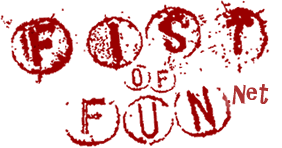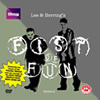Press Archives
Reference Articles
ON THE HOUR - By Radio Haha Radio 4
Series One 1991, Christmas special 1991, Series Two 1992
It would be no exaggeration to describe On The Hour as a landmark in the history of radio comedy.
This award-winning show was the first to truly penetrate the general, non-radio-listening public’s consciousness since The Hitch Hiker’s Guide To The Galaxy more than a decade earlier, and (many critics agreed) it was also the funniest thing to be broadcast since that time. Moreover, it brought to public attention a group of writers and performers who come close to constituting a ‘generation’ in their own right.
The central theme of On The Hour is very easily described: jokes about news. Not about what had happened in the news — this was a million miles from Week Ending — but about the way news is created and presented. If the show can meaningfully be said to have been responding to anything, it was responding to an increasing news-obsession which was based more in the media community than in the public at large.
This obsession was probably no stronger then than it is now, but it first became topical around the time On The Hour aired, probably owing to the BBC’s controversial plans to create a ‘rolling news network’ broadcasting non-stop news on the radio 24 hours a day — not, as was pointed out at the time, because of any particular demand for such a thing, but because ‘news’ was increasingly perceived as a good thing in its own right. To many people, the idea that ‘news’ should cease to consist of the mere reporting of events, and should become a cultural animal in its own right, persisting even in the absence of any worthwhile events to feed off, was intrinsically laughable; luckily On The Hour was there to do the laughing.
On The Hour’s perfect encapsulation of the new trend in news was unusual, wild and extreme. It did not (in the manner of earlier series such as Radio Active, which lampooned local radio) treat news broadcasting simply as a ready source of gags and situations; rather, it based its entire being on an uncompromising insistence that news was, in fact, a fundamental cosmic force, more important than food, money, religion or sex.
Each show was constructed to closely resemble a genuine news magazine, with sober-voiced headlines, reports, announcements, interviews, features and so forth. The difference came in the programme’s uncontrolled fervour: nothing — especially not the rampant absurdity of most of the situations and information presented — was allowed to get in the way of the all-powerful directive to inform.
The main presenter, Christopher Morris (who used his own name for his character in this and subsequent series) spoke in a newsreader’s monotone but behaved like a half-crazed zealot, providing such stirring exhortations to greater news-consciousness as the following: “Doctor Fact is knocking at the door. Someone — please — let the man in!” That, at any rate, is how On The Hour came across when it was first broadcast.
Since then, the various talents behind its construction have gone on to a variety of diverse projects: as a result, the original recordings now come across more as a composite of several well-established styles than as a seamless whole. Chief among these are Morris’s driving presentational style and unrestrained mockery, the skilful tape-editing and fiddling-about of series producer Armando Iannucci; and the sophisticated stupidity of the sketches and one-liners supplied by Richard Herring and Stewart Lee. All of these techniques and personalities received their first significant exposure in On The Hour.
The cast of the show, who provided voices for the various characters and reporters (but maintained a degree of separation from Morris, who would often present entire segments of the programme entirely solo) have likewise, without exception, achieved significant success in British comedy. Both series featured the same cast: Steve Coogan, Rebecca Front, Doon MacKichan, Patrick Marber and David Schneider. There was, especially in the second series, a certain amount of cast input into the script.
The other writers (alongside the core of Morris and the non-appearing Iannucci, Lee and Herring) were Steven Wells, Andrew Glover and David Quantick, the last of whom is now a noted music and pop-culture journalist. The series featured a selection of characters chosen to represent the full spectrum of ‘real’ current affairs broadcasting: environmental issues were dealt with by Rosie May and her ‘Green Desk’, US news (largely concerning unusual methods of executing serial killers) by “CBN’s Barbara Wintergreen”, religious homilising by ‘Monsignor Treeb-Lopez’, and so forth.
Particularly worthy of mention is the superbly-named on-the-spot reporter, Peter O’Hanrahahanrahan, whose interchanges with the domineering Morris generally reduced him to a gibbering wreck (“It’s the thin end of a very complex wedge.” “Peter! How can a wedge be complicated, for Christ’s sake?” “Er… it’s got wires on it”). But the best-known of all On The Hour’s characters is, of course, Coogan’s half-witted sports reporter Alan Partridge, who has since appeared in several other series and become something of a national hero.
Since his creation in the early days of On The Hour, Alan has evolved somewhat: many new details concerning his life have been filled in, and his voice has changed considerably; present from the outset, however, were the two qualities which have made him a star: an abiding love for the sound of his own name, and a deep-rooted ignorance of all areas of sport (a typical Partridge report, on a golfer taking a shot, climaxes with an ecstatic “…and he’s hit it!”) These characters, however, were only part of the On The Hour experience: as much as half of each show might be devoted to Morris’s solo rampages, while the programme was held together by the flawless presentational trickery of Iannucci, the presiding behind-the-scenes genius. The series provided the first glimpse of several tendencies which made their presences felt in the years to come, including Morris’s penchant for wind-up phone calls (including conversations with representatives of various newspapers concerning a purported tape of the then-Labour leader drunkenly shouting “Forget Paddy Pantsdown — I’m Neil Kingcock!” in a hotel bar), and Lee and Herring’s propensity for inserting the names of real people into their sketches (hence a succession of harrassed, put-upon or abused characters, all called Lionel Cosgrave after an unpopular former employer of Herring’s).
After two series, preparations began for a transfer to BBC2 television under the new title of The Day Today. It was at this point that an unfortunate dispute, principally over copyright, arose between Lee and Herring on the one hand, and the cast and producer on the other. Relations on a personal level appear to have healed quickly following this incident (with the notable exception of a continuing and notorious animosity between Patrick Marber and his two former co-writers); however, the dispute had a drastic effect on the content of the On The Hour tie-in BBC audio tape (see below), and meant that the duo did not contribute to The Day Today, which was thus somewhat different in style — but certainly up to the same standard. This television adaptation was unusual in replicating scarcely any of the old radio material.
The subsequent radio, television and stage credits of the On The Hour team are exceptionally numerous. Chris Morris, besides fronting The Day Today, pursued the ‘dangerous’ side of his career in a regular 1994 Radio 1 show, The Chris Morris Music Show, which hovered on the verge of a permanent ban for most of its existence, and later in the notorious Channel 4 mock-documentary Brass Eye; more recently he has returned to Radio 1 with Blue Jam, a late-night outpouring of wildly strange monologues and mood music.
Lee and Herring (now a fully-fledged double act) made the leap from writing to radio performance with Radio 4’s Lionel Nimrod’s Inexplicable World, which led to four series on Radio 1 (the first of which was entitled Lee and Herring’s Fist Of Fun, and the others simply Lee and Herring), and ultimately to BBC2 television with two series of Fist Of Fun and two of This Morning With Richard Not Judy. Producer Armando Iannucci also moved increasingly into performance, appearing in Lee and Herring’s early radio series and in a Radio 1 show of his own, Armando Iannucci (also featuring several On The Hour regulars), plus the documentary series In Excess and a showcase for his tape-fiddling skills, Down Your Ear.
Together with David Schneider and Peter Baynham (another core member of this incestous group, who came onto the scene shortly after On The Hour aired), Iannucci also developed and hosted BBC2’s satirical extravaganza, The Saturday [Friday] Night Armistice. The most notable spin-off from On The Hour was, of course, the meteoric rise of Alan Partridge, as played by Steve Coogan.
The entire cast, with the exception of Morris, collaborated on Partridge’s chat-show Knowing Me, Knowing You, which also transferred to television and is an issue in itself. Coogan is also known for his other televisual characters including the student-hating Mancunian, Paul Calf. Beside her theatre work, Doon MacKichan has had her own radio series, Doon Your Way, and been involved in various Comic Strip television projects; Patrick Marber has become a successful playwright, while Rebecca Front’s radio and television sitcom and drama appearances literally defy enumeration.
See also: the BBC Radio Collection double-audio cassette, On The Hour. A sad story surrounds this artefact. Partly as a result of the abovementioned dispute, Lee and Herring (whose total contribution comprised about 30 or 40% of the material in On The Hour, and was greater in the first series than in the second) were unhappy with the nature of this release and refused consent for any of their material to be included.
As a result, the tape consists of two hours’ worth of compiled recordings from which all trace of their input has been deleted; not only are many classic sketches missing, but the recordings have been noticeably altered to remove or alter anything which might be construed as Lee/Herring intellectual property (character names, for example).
This is a very unfortunate state of affairs, since the many new fans generated by the television series have never been able to hear the radio original in all its glory; however, much of the material which started life in On The Hour has since been salvaged by the duo for use or adaptation in their many subsequent projects.

